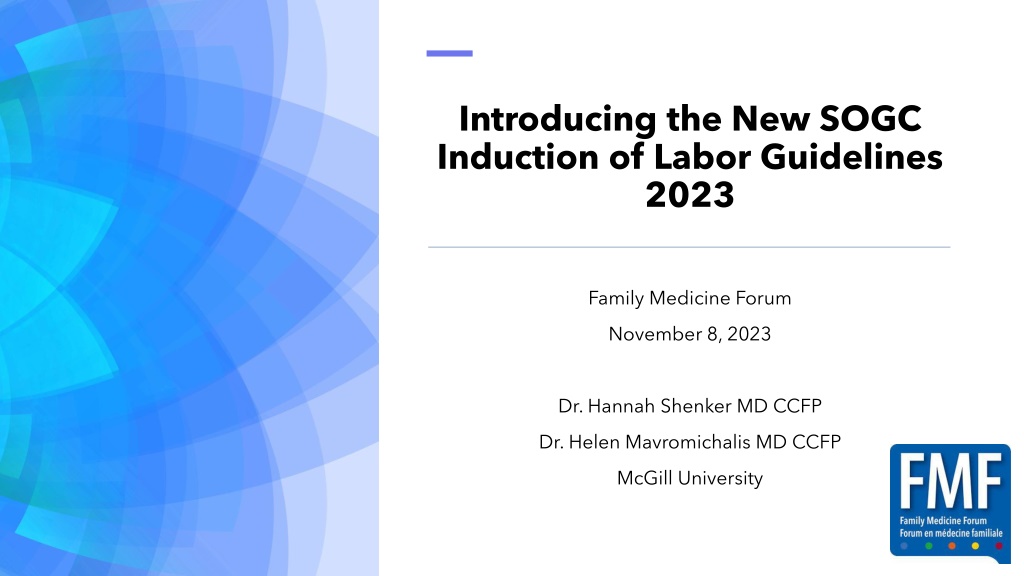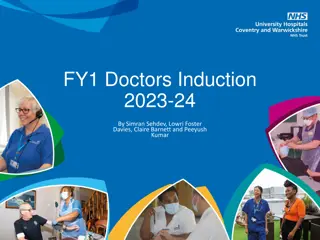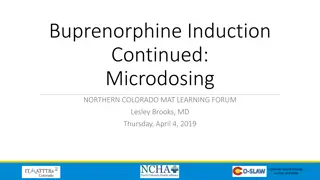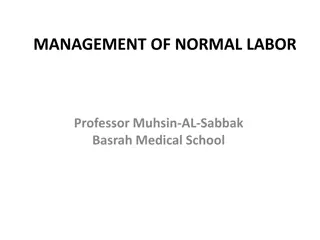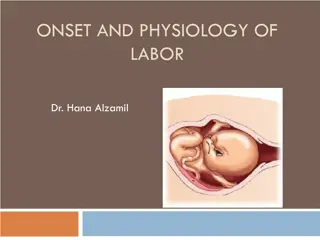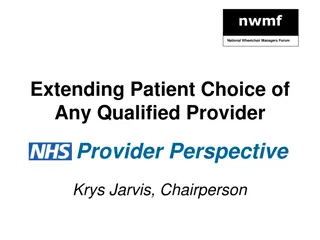Guidelines for Induction of Labor in Family Medicine Forum 2023
The new SOGC Induction of Labor Guidelines 2023 were introduced at the Family Medicine Forum by Dr. Hannah Shenker and Dr. Helen Mavromichalis from McGill University. The presentation discussed various scenarios for inducing labor and highlighted key recommendations, including the importance of shared decision-making and quality assurance audits. Indications for induction of labor, risks associated with it, and general principles were also addressed.
Download Presentation

Please find below an Image/Link to download the presentation.
The content on the website is provided AS IS for your information and personal use only. It may not be sold, licensed, or shared on other websites without obtaining consent from the author. Download presentation by click this link. If you encounter any issues during the download, it is possible that the publisher has removed the file from their server.
E N D
Presentation Transcript
Introducing the New SOGC Induction of Labor Guidelines 2023 Family Medicine Forum November 8, 2023 Dr. Hannah Shenker MD CCFP Dr. Helen Mavromichalis MD CCFP McGill University
Presenter Disclosure Neither Dr Hannah Shenker or Dr. Helen Mavromichalis have any conflicts of interest of financial support to disclose.
To Induce or not? How and when? 32 year old G4P3 GDM diet controlled with LGA infant (EFWT 4.2 kg) @ 38 wks 36 year old G1P0 GBS + PROM 8 hrs ago at 39+5 weeks. No CTX. 31 year old G1P0 @ 39 wks, low risk pregnancy, asking for elective IOL. 36 year old G2P1 @38+2. IUGR 6% with poor interval growth and oligohydramnios. 36 year old G2P1 TOLAC @ 41 wks. Cervix 1 cm, long. 39 year old G1P0 IVF pregnancy @ 39+2.
Key Recommendations: General Principles IOL should be a shared decision between the pregnant individual and the care provider, with respect for the individual s choice. All pregnant individuals should be offered a dating ultrasound at 8-12 weeks gestation. Routine elective induction of labor at 39 weeks gestation is not recommended. If requested, the provider should consider patient preferences, local health care resources, and local cesarean delivery rates associated with induction Quality assurance audits for induction of labor practices are important within health care organizations. Important quality measures include the indication for induction, the induction approach, and outcomes
Indications for Induction of Labor (not exhaustive) High Priority Other Indications Fetal growth restriction Diabetes requiring insulin/poor control Chorioamnionitis Term PROM with GBS + AMA 39 wks Cholestasis of pregnancy IUFD (or prior IUFD) Hypertensive Disorders of Pregnancy PET w/ severe features at any GA PET without severe features at 37 weeks Post term pregnancy 42 weeks Late term pregnancy (41-41+6 weeks) Oligohydramnios Gestational HTN 38 weeks (uncomplicated) Maternal disease not responding to treatment Suspected fetal Compromise Stable, significant antepartum hemorrhage Term PROM, GBS negative Uncomplicated twin pregnancy certain scenarios Logistical issues
Risks associated with IOL Failure to establish labor Tachysystole Chorioamnionitis Cord prolapse with ARM Uterine Rupture Assisted vaginal birth or Cesarien Delivery PPH Adverse neonatal outcomes related to iatrogenic early-term birth (37-39 wks) Short-term NICU admission, LBWT, Obstructive airway Dx, CP, Epilepsy, Intellectual disability, Low APGAR, Perinatal Mortality.
Non-Pharmacological methods Regular sweeping of the membranes may be offered from 38 wks to reduce the incidence of late term pregnancy. GBS colonization is not a contraindication to a membrane sweep. Castor oil, nipple stimulation, and breast compression can reduce the need for induction of labor and may be offered to low-risk individuals at term.
Key Recommendations: Specific scenarios Late term induction of labor should be offered at or after 41 weeks gestation. Suspected macrosomia or LGA alone is not an indication for induction before 39 weeks. Cesarean delivery may be considered for ultrasound estimated fetal weight >4500 g in the presence of diabetes and estimated fetal weight >5000 g in the absence of diabetes. Induction of labor may be offered at 39 weeks gestation for advanced maternal age ( 40 yrs) (LGA) refers to fetal weight >90th % for a given gestational age. There is insufficient evidence that IOL is associated with maternal or fetal benefits for pregnancies conceived via assisted reproductive technologies Macrosomia = EFWT 4000-4500 g, regardless of gestational age.
Case Study 36 year old G1P0 @ 39+5 weeks GA Presents to L+D with SRM x 8 hrs GBS + on vaginal-anal swab done @ 36 weeks No Allergies No CTX, normal fetal movements, clear fluid Afebrile, normal vitals, FHR 135 Birth Plan states no IOL unless absolutely necessary
Term PROM (37 weeks) For patients who are GBS + with term rupture of membranes, IOL should be offered as soon as resources allow, and antibiotic prophylaxis should be started while awaiting IOL. For patients who are GBS - with term PROM, IOL may be offered as soon as resources allow. Expectant management for up to 24 hours is also acceptable. Digital pelvic exams should be avoided until active labor begins, and then done only when indicated. Either oral misoprostol or oxytocin can be used for induction of labor in the setting of term PROM, regardless of Bishop score.
Case Study 31 year old G1P0 @ 39+0 weeks GA Healthy Normal Pregnancy 3rd trimester US showed EFWT 50%, normal fluid Asking for IOL, she read online that if she is induced now, it will reduce her chances of needing C/S. Cervix is closed, long, soft.
What about ARRIVE? Randomly assigned 6106 low-risk nulliparous pregnant people with a singleton fetus to induction of labor at 39-39+4 weeks gestation versus expectant management. No difference was found in the primary outcomes of perinatal death or severe neonatal complications. The frequency of CD was lower in the IOL group (18.6% vs. 22.2%; RR 0.84; 95% CI 0.76-0.93). Grobman WA, Rice MM, Reddy UM, et al. Labor induction versus expectant management in low-risk nulliparous women. N Engl J Med 2018;379:513-23.
How Can we interpret ARRIVE? Study demographics make the data and outcomes challenging to extrapolate to the typical Canadian population and should therefore be interpreted with caution. average age was 24 years median BMI was 30.3 44% had no private health insurance 48% were unemployed Indigenous representation was too low to be specifically reported. A 2022 publication found that while rates of induction at 39 weeks gestation increased substantially after publication of the ARRIVE trial, neither the overall CD rate nor the rate of pre- eclampsia decreased significantly. A 2021 meta-analysis of 16 randomized controlled trials (n = 8796) found no decrease in the CD rate with induction before 40 weeks. They did show a possible reduction in hypertension, meconium-stained amniotic fluid, and mean birth weight, as well as an increase in the length of maternal hospitalization. For individuals requesting IOL at 39 weeks gestation, consideration should be given to the available evidence, the population studied, and health care resources within each clinical setting.
Case Study 32 year old G4P3 @ 38 weeks GDM diet controlled Previous SVD x 3, BWT 3.2 kg, 3.4 kg, 3.6 kg Ultrasound shows EFWT 4.2 kg with normal fluid and placentation Normal fetal surveillance Cervix is 2 cm/50% mid position/ -2
(LGA) refers to fetal weight >90th % for a given gestational age. Macrosomia Macrosomia = EFWT 4000-4500 g, at any gestational age. 2015 RCT (n = 822) Pregnancies with an EFWT >95th%, including GDM with diet control Compared IOL at 37-38+6 to expectant management to 41 weeks Results: reduction in shoulder dystocia (RR 0.32; 95% CI 0.15-0.71) reduction in neonatal fractures (RR 0.20; 95% CI 0.04-0.92). The IOL group had a lower average birthweight (3831 g vs. 4118 g) and a higher likelihood of needing phototherapy Suspected macrosomia or LGA alone is not an indication for induction before 39 weeks. Discussions with patients should include the limitations of ultrasound to accurately predict fetal weight. Meta-analysis of 56 studies using ultrasound to predict fetal weight >4000 sensitivity 56% specificity 92% the tendency is to overestimate fetal weight 1. Boulvain M, Senat M-V, Perrotin F, et al. Induction of labor versus expectant management for large-for-date fetuses: a randomized controlled trial. Lancet 2015;385:2600-5. 2. Malin GL, Bugg GJ, Takwoingi Y, et al. Antenatal magnetic resonance imaging versus ultrasound for predicting neonatal macrosomia: a systematic review and meta-analysis. BJOG 2016;123:77e88.
Macrosomia There is insufficient data to recommend IOL at a specific gestational age for suspected fetal macrosomia. A risk reduction strategy giving importance to individual patient preferences should be taken. Discussion should include The potential maternal morbidity associated with C/S delivery Risk of urinary and anal incontinence Risk of instrumental delivery Risk of shoulder dystocia to the mother and infant Neonatal risks associated with early term birth before 39 weeks Cesarean delivery may be considered for EFWT >4500 g with GDM EFWT >5000 g without GDM.
Case Study 44 year old G4P3 @ 39+0 weeks GA Previous SVD x 3 GDM diet controlled Normal Fetal Surveillance and BP 3rd trimester US showed EFWT 29%, normal fluid Cervix 0.5 cm/25%/-3, posterior cervix. Cephalic presentation.
Key Recommendations Cervical ripening should occur whenever the Bishop score is less than 7. For outpatient settings, the preferred method of cervical ripening is the use of a cervical balloon. Where insertion of a cervical balloon is not possible, use of prostaglandin E 2 is recommended. For individuals requiring inpatient cervical ripening, the preferred options are balloon, oral misoprostol, or both concurrently. Health care providers should be cautious when using any prostaglandin in a potentially compromised fetus
Key Recommendations Health care providers should not offer amniotomy or oxytocin until the modified Bishop score is 7. Should cervical ripening and/or IOL be unsuccessful, consider an alternative or combined method of cervical ripening and/or IOL before proceeding with cesarean delivery
The modified Bishop score should be used and documented to determine if cervical ripening is required The 2 variables predictive of a successful IOL are the condition of the cervix prior to induction (with intact membranes) and prior vaginal delivery. There is an increased rate of C/S when IOL is undertaken with a Bishop score <7 (outside the setting of PROM).
GBS + All cervical ripening agents are appropriate for individuals who are colonized with GBS. Antibiotics should be started when the patient is in active labor or with rupture of membranes.
Case Study 36 year old G2P1 @ 38+2 weeks GA Ultrasound requested because fundal height measuring small for dates Previous SVD 3 years ago at 40 wks, BWT 3.4 kg Normotensive, GDM screen normal. U/S shows IUGR 6% with oligohydramnios and poor interval growth. Uterine artery doppler studies normal.
Mechanical Options for Cervical Ripening: Balloon Catheters equally effective as PGE2 (i.e Cervidil) slightly less effective than prostaglandin PGE1 (Misoprostol) greater safety profile than prostaglandins lowest risk of uterine rupture in a previously scarred uterus similar incidence of maternal and neonatal infection compared with pharmacologic agents highly suitable for outpatient use should be avoided with ruptured membranes Caution where there is evidence of a lower tract genital infection
Single balloon catheters are more cost effective than double balloon catheters. inflate with 30-60 mL of water after passing the balloon through the internal cervical os. The catheter is left in place for up to 24 hours. Adding tension does not confer benefit. Cook Balloon (double lumen)
Pharmacologic Options for Cervical Ripening Misoprostol (PGE1 ) Vaginal Dinoprostone (PGE2) highly effective as both a cervical ripening and induction agent stable at room temperature, economical, and has multiple routes of administration Fever can be seen with high doses (400mcg) but rarely with IOL dosing can cause uterine tachysystole, with or without fetal heart rate changes. increases successful vaginal birth within 24 hours without increasing the incidence of assisted vaginal birth or C/S rates available as a controlled-release vaginal mesh (cervidil) or intravaginal gel maternal side effects include fever, chills, vomiting, and diarrhea can cause uterine tachysystole, with or without fetal heart rate changes.
The evidence for PGE1 A 2016 systematic review of 20 interventions for IOL 2010 Cochrane review of 121 trials comparing vaginal misoprostol with no treatment or other methods of IOL 2020 randomized controlled trial (n = 4400) compared titrated oral misoprostol in doses of 20-50 mg with vaginal dinoprostone. serious adverse events with the use of misoprostol were similar to other prostaglandins and oxytocin, with similar or better efficacy. vaginal doses of 25 mg of misoprostol resulted in a greater need for oxytocin augmentation, but less uterine tachysystole (with and without fetal heart rate changes) The oral misoprostol group showed: higher vaginal delivery rates (78.3% vs. 72.9%; P 0.005) less tachysystole with fetal heart rate changes (3.6% vs. 8.6%; P= 0.007) less abnormal fetal heart rate tracings (8.9% vs. 15.4%, P =0.006) no difference in uterine tachysystole with abnormal fetal heart rate. doses of 50 mg significantly increased the incidence of vaginal birth within 24 hours. 1. Wang X, Zhang C, Li X, et al. Safety and efficacy of titrated oral misoprostol solution versus vaginal dinoprostone for induction of labor: a single-center randomized control trial. Int J Gynaecol Obstet 2021;154:436e43. 2. Alfirevic Z, Keeney E, Dowswell T, et al. Which method is best for the induction of labour? A systematic review, network meta-analysis and cost-effectiveness analysis. Health Technol Assess 2016;20:1e584. 3. Hofmeyr GJ, G lmezoglu AM, Pileggi C. Vaginal misoprostol for cervical ripening and induction of labour. Cochrane Database Syst Rev 2010;10:CD000941.
Pharmacokinetics of Misoprostol (PGE1) Oral, sublingual, and vaginal routes all cause an increase in uterine tone after a single dose. Within 1- 2 hours of an oral dose, serum levels fall and effects on uterine activity subside due to extensive first- pass hepatic metabolism. Due to the longer half-life of (ALL) prostaglandins, clinicians should proceed with caution where there is an increased likelihood of tachysystole, fetal compromise, or uterine rupture. With both SL and vaginal dosing, the increased resting tone is replaced by rhythmic contractions after 1-2 hours, which last for 3-4 hours.
Outpatient Use of Cervical Ripening Agents 2020 meta-analysis of outpatient vs inpatient cervical ripening using PGE2 or balloon catheters found no difference in outcomes or safety. ** in low-risk and high-resource populations Conditions for inpatient management include Risk factors for an adverse perinatal outcome Transportation challenges or environmental considerations Dong S, Khan M, Hashimi F, et al. Inpatient versus outpatient induction of labour: a systematic review and meta-analysis. BMC Pregnancy Childbirth 2020;20:382.
Key Recommendation Oral misoprostol in a titratable fashion or oxytocin with amniotomy is the preferred method of induction of labor when the Bishop score is 7 or greater.
2021 Cochrane systematic review and meta-analysis for induction of labor: The best available evidence suggests that low-dose oral misoprostol probably has many benefits over other methods for labor induction. This review supports the use of low-dose oral misoprostol for induction of labor and demonstrates the lower risks of hyperstimulation than when misoprostol is given vaginally. More trials are needed to establish the optimum oral misoprostol regimen, but these findings suggest that a starting dose of 25 mg may offer a good balance of efficacy and safety.
Re: Off Label Use of Misoprostol for IOL Misoprostol has been studied in >100 000 pregnancies, has been used worldwide for >15 years, and is recommended in other international IOL guidelines. Therefore, misoprostol should be included as part of the informed decision-making process for induction of labor.
Oral misoprostol for IOL (Bishops 7) Advantageous 2-hour half-life and allows for titratable dosing The dose should be started at 20-25 mg and titrated to contractions up to 50 mcg/dose. Continuous EFM is recommended for at least 20 minutes post administration. When signs of active labor present, establish EFM. Continue ambulation as per fetal health surveillance guidelines Once active labor has commenced and/or the membranes are ruptured, the clinician is not required to switch from misoprostol to oxytocin, as continuing with misoprostol may be more effective
Absolute contraindications to PGE 1 use Previous full thickness uterine surgery Known fetal compromise
Case Study 36 year old G2P1 @ 41 weeks GA Healthy Previous C/S 26 months ago for breach presentation EFWT @ 36 weeks 60%, normal fluid and placentation Would like TOLAC, No CTX or SRM Cervix is 3 cm/75%/-2 cephalic presentation
Oxytocin for IOL Oxytocin is a hormone that binds to uterine receptors to produce contractions. No direct effects on the cervix. Administered as a controlled IV infusion for IOL Half-life of 1-6 minutes and a time to steady plasma concentration of 40 minutes. Dosing regimen of oxytocin should be individualized and titrated to uterine activity, The uterus is increasingly responsive to oxytocin as pregnancy progresses and decreasingly responsive with prolonged labor due to the saturation of receptors. Volume overload and hyponatremia may occur with high doses (>40 mU/minute) or prolonged infusion Continuous EFM should be utilized with oxytocin infusions due to the risk of uterine tachysystole with fetal heart rate (FHR) changes. Early amniotomy after starting oxytocin is associated with shorter IOL to delivery intervals.
Low-Rate versus Expedited-Rate Oxytocin Protocol The actual dose of oxytocin is the same in both regimens, only the time to reach that dose is altered.
IOL for Trial of Labor after Cesarean. What about the risk of Uterine Rupture? Although oxytocin can increase the risk of uterine rupture somewhat, it is the safest method of IOL with prior uterine surgery
